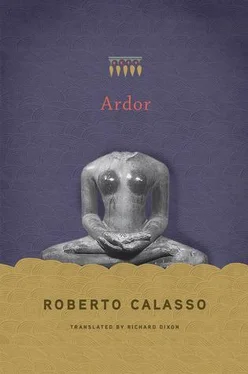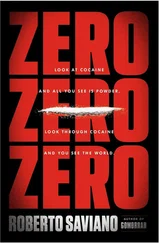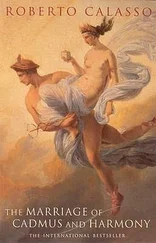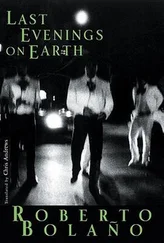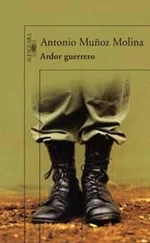The kṣatriyas , on the other hand, were eager not just for power. On many occasions, especially in the Upaniṣads (but also in the Brāhmaṇas), we meet kṣatriyas who enlighten illustrious brahmins on certain extreme doctrines, on points that the brahmins themselves could not fathom.
* * *
There is an enormous variance between the rudimentary physical remains of the Vedic civilization and the complexity, difficulty, and boldness of its texts. In the cities of the Indus, bricks were used for construction; storehouses and vast water tanks were created. The Vedic people knew about bricks and used them, but only for piling up on the fire altar. A whole theology was developed around “bricks,” iṣṭakā , which were associated with “oblation,” iṣṭi. And building itself was first and foremost a ritual. The elements of daily life could not have been simpler, but their meanings appeared overwhelming. Though reduced to the minimum, everything was always too much. Even a cautious and laconic scholar like Louis Renou recognized that “the Veda moves in a state of panic.” In contrast to all priestly rigor, the hymns seemed to him to be not just “poems composed in ‘cold blood,’” but “frenetic works, produced in an atmosphere of oratorical jousting, where victory is gained by best formulating (or: most rapidly guessing) the mystical-ritual-based enigmas.” And where defeat could mean a sentence of death. Heads burst into pieces, with no need of an executioner. There is no lack of documented cases.
* * *
Among all those who belonged to the Indus civilization, we know one name alone: Su-ilisu, an interpreter. He appears as a dwarf, or a child, on an Akkadian seal. He is sitting on the lap of a person wearing rich, heavy ornaments. The words carved over the image read: “Su-ilisu, translator of Meluhha.” Other seals speak of merchandise from Meluhha, from that Indus civilization whose territory was bigger than that of Mesopotamia, Egypt, and Persia, and which lasted at least a thousand years, finally dying out, for reasons entirely unknown, around 1600 B.C.E. The names are lost. The only one that remains is that of Su-ilisu, interpreter of a language that still resists all attempts to decipher it — assuming that it is a language, a point over which there is still dispute.
For several years there have been feverish attempts to unearth horse bones in the Punjab. Brandished as blunt weapons, they were supposed to have been used to defeat and disperse the odious Indo-Europeans who were said to have come from outside , from beyond the Khyber Pass. Thus it would be proved that their innovation — the horse — was already to be found in those regions. For — according to some — all that is most ancient and memorable must necessarily grow on Indian soil. And the undeciphered script of Harappa should already contain quite enough to make it clear that Sanskrit and the Ṛgveda descend from there. None of this has been supported by the archaeological evidence, and it goes against what is said in the Vedic texts. The soma , whatever it might have been, grew in the mountains, which aren’t part of the landscape of Harappa and Mohenjo-daro. As for warriors riding on chariots with horses, there is no trace of them in the seals of the Indus civilization. If one compares it with the Ṛgveda , it is difficult to avoid the impression that they are two parallel worlds. And yet they must have come into contact in some manner. But in some manner that still remains unclear.
* * *
In Vedic India, history was not something worthy of note. Historiography makes its appearance much later, not just many centuries after Herodotus and Thucydides, but at the time when the medieval chronicles were being written in the West. The chronology to which the ritualists refer is generally a time of the gods and of what took place before the gods. Only in rare cases is reference made to something “antiquated,” so as to indicate a passage to the time of mankind. And invariably it relates to changes within a ritual. For example, in the most complicated and impressive ritual, the aśvamedha , the “horse sacrifice”: “That aśvamedha is, so to speak, an antiquated sacrifice, for what part of it is celebrated and what part not?” After having followed the meticulous, bewildering instructions on the hundreds of animals to be sacrificed during the aśvamedha and on the various ways they had to be treated, on the beads to be threaded into the mane of the horse and on the “ways of the knife” that had to be followed when cutting into the flesh of the horse, making a sudden change of course it is said that the “ aśvamedha is an antiquated sacrifice” (or “abandoned,” utsannayajña). Perhaps the speculations of the liturgists already related to a glorious lost past, when there was still a perfect link between the chants, the numbers, and the animals killed. Perhaps they already felt like seventeenth-century scholars waging a war of quotations over some long-gone event. But the fewer the references to the pure, corrosive sequence of time, the more devastating are their effects. And any attempt to establish an immediate, simple, and unambiguous relationship between the texts of the Vedic ritualists and any factual reality will appear all the more futile. Unlike the Egyptians, the Sumerians, or the Chinese of the Zhou dynasty, they avoided linking events to the years. Verum ipsum factum did not apply. Liturgical acts were the only factum connected to a verum. All that was carried out before and outside the ritual belonged to the vast frayed realm of untruth.
* * *
Vedic India is founded on a rigorous exclusivity (only those who take part in the sacrifice can be saved) and at the same time on a need for total redemption (extending not only to all humans, but to all living beings). This twofold claim, which will sound unreasonable to the other great religions (which are more closely bound to secular good sense) reappears in the picture of an ancient, endless feast: “But those creatures that are not admitted to the sacrifice are lost; he therefore admits to the sacrifice those creatures here on earth who are not lost; behind mankind are the beasts; and behind the gods are the birds, the plants and the trees; and so whatever exists here on earth is admitted to the sacrifice. And verily, both gods and men and their forebears drink together, and this is their feast; in ancient times they drank together visibly, but now they do so in the invisible.”
Nothing else was as serious, for gods just as much as for men, as being excluded from the sacrifice. Nothing was so certain to bring loss of salvation. Life, alone, was not enough to save life. There had to be a form, a sequence of gestures, a constant endeavor to avoid perdition. And for salvation to happen, it had to extend to everything, it had to carry everything with it. There was no salvation of the individual — being or species. Behind mankind could be glimpsed the incalculable multitudes of beasts, united with man by their being paśu , potential sacrificial victims. Whereas behind the gods rustled all the trees and shrubs, with their inhabitants, the birds, which had easier access to the sky.
This overwhelming vision is offered in few words — and has no equivalent in any of the other great ancient civilizations. There is no trace of it in any Greek (not to mention Roman) texts, it is certainly not a biblical view (where man, since the very beginning in the Garden of Eden, is branded as the dominator), nor in any Chinese texts. Only the cruel Vedic people, as they relentlessly devoted themselves to bloody sacrifices, thought about how to save the trees, the plants, and all other living beings, together with themselves. And they thought it could be done in only one way: to admit all those creatures to the sacrifice. They also thought it was the only way of overcoming the toughest challenge — the perpetuation of that invisible feast which had once been visible to all, and in which all took part.
Читать дальше
